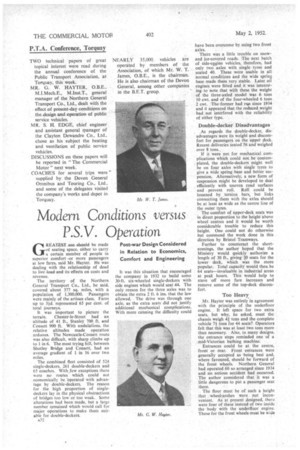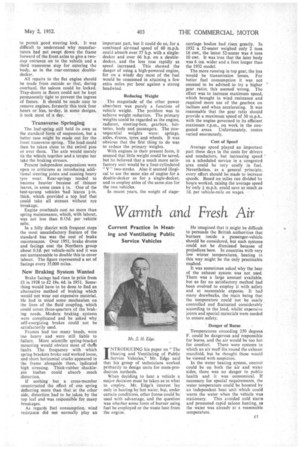Modern Conditions versus
Page 34

Page 39

If you've noticed an error in this article please click here to report it so we can fix it.
P.S.V. Operation
GREATEST use should be made of seating space, either to carry a certain number of people in superior comfort -or more passengers at low fares, said Mr. Hayter. He was dealing with the relationship of dead to live load -and its effectson costs and revenue.
The territory of the Northern General Transport Co., Ltd., he said, covered about 377 sq. miles, with a population of 1,300,000. 'Passengers were mainly of the artisan class. Fares up to 31d. represented 65 per cent. of total journeys.
It was important to picture the terrain. Chester-le-Street had an altitude of 41 ft., Stanley 700 ft. and Consett 900 ft. With undulations, the relative altitudes. made operation arduous. The Newcastle-Consett route was also difficult, with sharp climbs up to 1 in 6. The most trying hill, between Shotley Bridge and Consett, had an average gradient of 1 in 16 over two in des.
The combined fleet consisted of 524 single-deckers, 261 double-deckers and 65 coaches. With few exceptions there were no routes which could not economically be 'operated with advantage by double-deckers. The reason for the high proportion of singledeckers lay in the physical obstructions of bridges too low or too weak. Some alterations had been made, but a large number remained which would call for major operations to make them suitable for double-deckers.
A32 it was this situation that encouraged the company in 1932 to build some 30-ft. six-wheeled single-deckers with side engines which would seat 44, The only reason for the three axles was to obtain the extra 2 ft. 6 ins, that the law allowed. The drive was through one axle, as the extra seats did not justify additional mechanical complications. With more ctinning the difficulty could have been overcome by using two front axles.
There was a little trouble on snowand ice-covered roads. The next batch of side-evgine vehicles, therefore, had only two axles with single tyres and seated 40. These were usable in all normal conditions and the wide spring base made them very stable. Later oil engines were fitted and it was interesting to note that with these the weight of the three-axled model was 6 tons 10 cwt. and of the four-wheeled 6 tons 2 cwt. The-former had run since 1934 and it appeared that; the reduced weight had not interfered with the reliability of either type.
Double-decker Disadvantages
As regards the double-decker, disadvantages were its Weight and discomfort for passengers on the rupper deck. Recent deliveries Seated 56 and' weighed over 8 tons., If it were not for mechanical complications which could not be contemplated, the double-deckers might well be on four axles with single tyres to give a wide spring base and better suspension. Alternatively, a new form of suspension might be developed to deal efficiently with uneven road surfaces and prevent roll. Roll could be lessened by torsion bars, but links connecting them with the axles should be at least as wide as the centre line of the outer tyres.
The comfort of upper-deck seats was in direct proportion to the height above wheel centres and it would be worth considerable trouble to reduce this height. One could not do otherwise but commend the work done in this direction by Bristol Tramways.
Further to counteract the shortcomings, the author hoped that the Ministry would quickly authorize a length of 30 ft., giving 3.0 seats for the lower deck, which was the more popular. Total capacity would then be 64 seats—invaluable in industrial areas at peak hours. This would help to stave 'off more fare increases and remove some of the top-deck discomfort.
Too Heavy
Mr. Hayter was entirely in agreement with the principle of the underfloor engine. It left space for two extra seats, but why, he asked, must the chassis weigh 4i tons and the complete vehicle 7-1tons for 44 seats? Operators felt that this was at least two tons more than necessary. Also, in many designs, the entrance steps reminded one of a ,mid-Victorian bathing machine.
Entrances could be at the centre, front or rear. Front entrances were generally accepted as being best and. where favoured, should be forward of the front wheels. Northern General had operated 60 so arranged since 1934 and no serious accident had occurred. The author considered that it was a little dangerous to put a passenger seat there.
The floor must be of such a height that wheel-arches were not inconvenient. As at present designed, there were four of these instead of two inside the 'body with the underfloor engine. Those for the front wheels must be wide to permit good steering lock. It was difficult to understand why manufacturers had not swept down the frame forward of the front axles to give a twostep entrance on to the vehicle and a third transverse step for entering the body, as in the rear-entrance doubledecker.
All repairs to the flat engine should be made from outside so that, during overhaul, the saloon could be locked. Trap-doors in floors could not be kept permanently tight to prevent the ingress of fumes. It should be made easy to remove engines, formerly this took four hours or less, to-day, in some designs, it took most of a day.
Transverse Springing
The leaf-spring still held its own as the standard form of suspension, but a better case might be made out for the front transverse spring. The load could then be taken close to the swivel pins or over them. The axle would merely tie the wheels together and a torque bar take the braking stresses.
Present independent suspensions were open to criticisms as introducing additional steering joints and causing heavy tyre wear. Rear-springs tended to become heavier because of thinner leaves, in some cases in. One of the best-sprung vehicles 'had leaves fin. thick, which provided a top leaf that could take all stresses without eye breakage.
Engine overhauls cost no more than spring maintenance, which, with labour, was not less than 0.15d. per vehicle mile.
In a hilly district with frequent stops the most unsatisfactory feature of the standard bus was the cost of brake maintenance. Over 1951, brake drums and facings cost the Northern group about 0.1d. per vehicle-mile and it was not unreasonable to double this to cover labour. The figure represented a set of facings every 35,000 miles.
New Braking System Wanted
Brake facings had risen in price from £1 in 1938 to £2 19s. 4d. in 1951. Something would have to be done to find an alternative method of braking which would not wear out expensive material. He had in mind some mechanism on the lines of the fluid coupling, which could cover, three-quarters of the braking needs. Modern braking systems were complicated and he asked why self-energizing brakes could not be satisfactorily used.
Frames had too many bends, were too heavy and were still liable to failure. More scientific spring-bracket mounting would obviate most of diet faults. The frequency with which spring brackets broke and worked loose, and short horizontal cracks appeared in the frame alongside them, indicated high stressing. Thick-rubber shacklepin bushes could absorb much distortion.
If nothing but a cross-member counteracted the effect of one spring deflecting more than that at the other side, distortion had to be taken by the top leaf and was responsible for many breakages.
As regards fuel consumption, wind resistance did not normally play an important part, but it could do so, for a combined air-road speed of 60 m.p.h. could absorb over 37 h.p. with a singledecker and over 66 Ii.p. on a doubledecker, and the loss rose rapidly as speed increased. This showed the danger of using a high-powered engine, for on a windy day most of the fuel would be consumed in attaining a few extra miles per hour against a strong headwind.
Reducing Weight
The magnitude of the other power absorbers was purely a function of vehicle weight. The problem was to achieve weight reduction. The primary weights could be regarded as the engine, radiator, steering-box, gearbox, batteries, body and passengers. The consequential weights were springs, axles, 'frame, tyres and wheels. It was obvious that the first thing to do was to reduce the primary weights.
With engines in their present form, it seemed that little weight could be saved, but he believed that a much more satisfactory unit would he a four-cylindered " V " two-stroke. Also it seemed illogical to use the same size of engine for a double-decker as for a single-decker, and to employ axles of the same size for the two vehicles.
In recent years, the weight of stage carriage bodies had risen greatly. In 1932 a 52-seater weighed only 2 tons 16 cwt., the latest 52-seater was 4 tons 10 cwt. It was true that the later body was 6 ins, wider and a foot longer than the 1932 model.
The more running in top gear, the less would be transmission losses. For better fuel consumption it was not unusual to be advised to try a higher gear ratio; this seemed wrong. The effect was-to increase maximum speed, which brought in wind resistance and required more use of the gearbox on inclines and when accelerating. It was reasonable that the gear ratio should provide a maximum speed of 30 m.p.h., with the engine governed to its efficient maximum r.p.m., on work in the congested areas. Unfortunately, routes varied enormously.
• Cost of Speed Average speed played an important part these days in the costs for drivers and conductors, but increasing speed on a scheduled service in a congested area could be very costly in fuel. Nevertheless, as a general principle, every effort should he made to increase speeds. Based on miles run divided by hours worked, raising the average speed by only m.p.h. could save as much as Id. per vehicle-mile on wages.




















































































